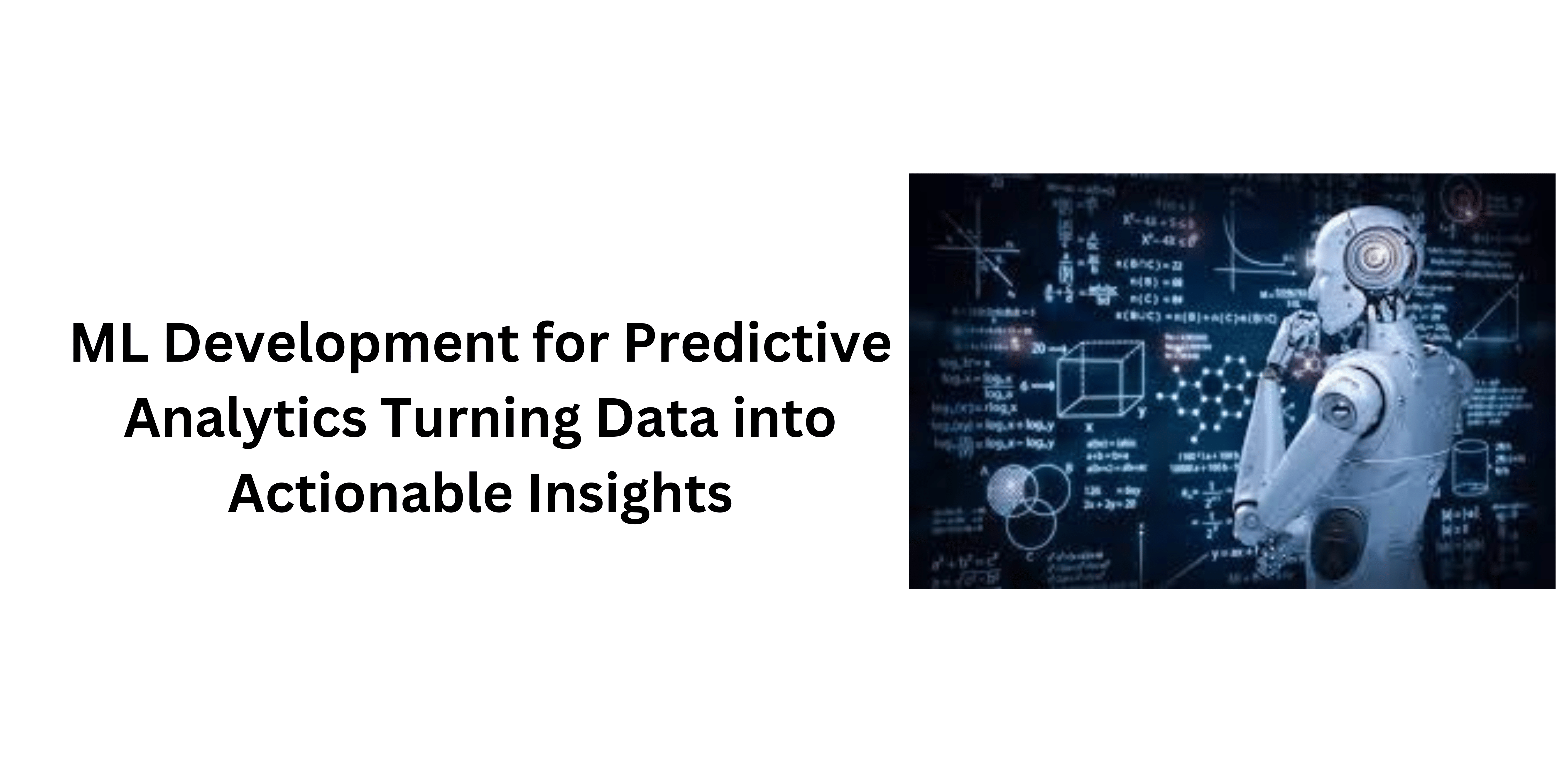In the rapidly evolving landscape of data-driven decision-making, the integration of ML development into Predictive Analytics has become paramount for transforming vast datasets into actionable insights. This synergy between advanced analytics and machine learning not only empowers organizations to glean valuable information from their data but also enables them to anticipate future trends and make informed strategic decisions.
The introduction of ML in predictive analytics signifies a paradigm shift, where algorithms learn from historical data patterns, adapt to changing trends, and forecast outcomes with remarkable accuracy. This intricate process involves key stages such as data preprocessing, algorithm selection, model training, and continuous refinement.
Understanding the nuances of machine learning development in predictive analytics is essential for navigating the complexities of data analysis, ensuring optimal model performance, and ultimately turning raw data into actionable intelligence. This introduction sets the stage for a comprehensive exploration of the various facets involved in this dynamic field, aiming to demystify the intricacies and highlight the significance of ML in extracting meaningful insights from voluminous datasets.
Understanding the Role of Machine Learning in Data Analysis
Understanding the role of Machine Learning (ML) in data analysis is pivotal in unlocking the true potential of vast and complex datasets. Unlike traditional methods, ML goes beyond static rule-based programming by allowing algorithms to learn patterns and make data-driven predictions. At its core, ML enables data analysts to not only uncover insights but also to develop predictive models that adapt and improve over time.
One crucial aspect is the ability to handle large volumes of data efficiently, identifying intricate patterns and relationships that may elude conventional analytical approaches. ML algorithms excel at recognizing trends and outliers, making them invaluable for extracting actionable information from diverse datasets. Moreover, ML facilitates the automation of repetitive tasks, streamlining the data analysis process and freeing analysts to focus on more complex, strategic aspects of decision-making. The integration of ML in data analysis empowers organizations to derive meaningful insights from structured and unstructured data sources, enabling them to make informed decisions and gain a competitive edge.
Whether in identifying customer behavior, predicting market trends, or optimizing business processes, ML’s adaptive nature enhances the accuracy and efficiency of data analysis, fostering a dynamic approach to extracting knowledge from information-rich environments. In essence, understanding the role of ML in data analysis is key to harnessing the full potential of modern analytics, driving innovation, and staying ahead in today’s data-driven landscape.
Key Components of ML Models for Predictive Analytics
The construction of effective Machine Learning (ML) models for predictive analytics involves a careful consideration of several key components, each playing a critical role in the model’s performance and accuracy. First and foremost is feature selection, where relevant variables or attributes are chosen from the dataset to serve as inputs for the model.
The quality and relevance of these features directly impact the model’s ability to discern patterns and make accurate predictions. Data preprocessing is another essential step, involving tasks such as handling missing values, normalizing data, and addressing outliers to ensure the dataset is conducive to robust model training. Selecting the appropriate ML algorithm is a crucial decision, as different algorithms exhibit varying strengths based on the nature of the data and the prediction task at hand. The training process involves exposing the model to historical data, allowing it to learn patterns and relationships. Once trained, the model undergoes evaluation using distinct datasets to assess its performance and generalizability.
Regularization techniques are often employed to prevent overfitting and enhance the model’s ability to generalize well to new, unseen data. Hyperparameter tuning fine-tunes the model’s configuration, optimizing its predictive capabilities. Interpretability is increasingly recognized as important, especially in fields where model decisions impact human lives or critical decisions. Post-training, continuous monitoring and updating ensure that the model adapts to changing patterns over time. These key components collectively form the foundation of ML models for predictive analytics, underscoring the multidimensional nature of constructing accurate and reliable predictive tools in data-driven decision-making.
Data Preprocessing Techniques for Effective Predictive Modeling
Data preprocessing stands as a cornerstone in the realm of effective predictive modeling, serving as a vital precursor to robust and accurate machine learning outcomes. This crucial step involves a series of techniques aimed at refining raw data, enhancing its quality, and preparing it for the subsequent stages of modeling. Handling missing data is a fundamental aspect, necessitating strategies like imputation or removal to prevent distortions in model training.
Outliers, anomalies, or noisy data points are addressed through techniques such as trimming, binning, or transformations to ensure that extreme values do not unduly influence the model. Standardization and normalization are employed to bring disparate features onto a consistent scale, preventing certain variables from dominating the model due to their larger magnitude. Categorical data requires encoding, translating non-numeric variables into a format understandable by machine learning algorithms.
Feature engineering involves creating new relevant features or transforming existing ones to capture additional insights, amplifying the model’s ability to discern patterns. Reducing dimensionality through techniques like Principal Component Analysis (PCA) helps manage computational complexity and improve model efficiency. Furthermore, addressing class imbalances in the target variable ensures that the model is not skewed towards predicting the majority class. Data preprocessing, therefore, is a meticulous process wherein the quality and suitability of the dataset significantly influence the predictive model’s performance. Implementing these techniques not only optimizes model training but also aids in mitigating biases, enhancing interpretability, and ultimately contributes to the generation of meaningful and reliable predictive insights from diverse datasets.
Feature Selection Strategies to Enhance Model Performance
Feature selection stands as a pivotal strategy in enhancing the performance of predictive models, serving to streamline the input variables and amplify the model’s predictive power. In the complex landscape of machine learning, not all features contribute equally to the predictive accuracy, and some may even introduce noise or redundancy. Consequently, effective feature selection involves choosing the most relevant and impactful variables while discarding those that add minimal value.
Univariate methods assess the significance of each feature independently, allowing the identification of variables with the most discriminative power. Alternatively, multivariate methods evaluate the interdependencies among features, capturing synergies that may be missed by univariate approaches. Recursive Feature Elimination (RFE) systematically removes the least important features, iteratively refining the model’s input set. Regularization techniques, such as L1 regularization (Lasso), induce sparsity by penalizing less influential features, facilitating automatic feature selection during model training. Information gain, mutual information, and tree-based methods like Random Forest can also guide feature selection by measuring the variables’ contribution to reducing uncertainty or improving model performance. Striking a balance between reducing dimensionality and preserving crucial information is paramount, as overly aggressive feature selection may lead to information loss.
Incorporating domain knowledge can further refine the process, as experts may provide insights into the relevance of specific features within the context of the problem domain. In essence, employing judicious feature selection strategies not only optimizes model training time but also enhances the model’s interpretability, generalizability, and predictive accuracy, ensuring that the selected features encapsulate the most salient aspects of the data for effective decision-making.
Choosing the Right Machine Learning Algorithm for Your Data
Selecting the appropriate machine learning (ML) algorithm is a pivotal decision in the development of predictive models, as the performance and effectiveness of the model hinge on the compatibility between the algorithm and the characteristics of the data at hand. The diverse landscape of ML algorithms encompasses various approaches, each tailored to specific types of data and prediction tasks.
Classification problems, for instance, may benefit from algorithms like Support Vector Machines (SVM), Decision Trees, or Random Forests, each with its strengths in handling different types of data distributions and complexities. Regression tasks, on the other hand, may find Linear Regression, Gradient Boosting, or Neural Networks as suitable options, depending on the nature of the data and the relationships between variables. Unsupervised learning scenarios, such as clustering or dimensionality reduction, may involve algorithms like K-Means, Hierarchical Clustering, or Principal Component Analysis (PCA).
The choice between these algorithms depends on factors like the size of the dataset, the dimensionality of the features, the presence of outliers, and the underlying assumptions about the data distribution. It is crucial to conduct thorough exploratory data analysis and understand the intricacies of the problem domain to inform the algorithm selection process accurately. Furthermore, iterative experimentation and model evaluation play a significant role in refining the choice of algorithm, as the performance metrics and the ability to generalize to new, unseen data guide the decision-making process. In essence, choosing the right ML algorithm for a specific dataset involves a nuanced understanding of the data’s characteristics and the problem’s requirements, aligning the algorithmic approach with the intricacies of the underlying patterns for optimal predictive performance.
Model Training and Evaluation in Predictive Analytics
Model training and evaluation constitute the heart of predictive analytics, representing a dynamic interplay between learning from historical data and assessing a model’s predictive prowess. In the training phase, a machine learning algorithm processes a dataset, discerning patterns, and building a predictive model. This involves splitting the data into training and validation sets, allowing the model to learn from the training data while assessing its performance on unseen validation data.
The choice of evaluation metrics, such as accuracy, precision, recall, or F1 score, depends on the nature of the predictive task and the desired trade-offs between different types of errors. Cross-validation techniques further enhance the reliability of the evaluation process, mitigating the risk of overfitting to a specific dataset. The iterative nature of model training involves tweaking hyperparameters, adjusting feature representations, and refining the model’s architecture to achieve optimal performance. Model evaluation is not a one-time affair; it is an ongoing process that includes monitoring a model’s performance on real-world data and adapting to changes in the underlying patterns. Overfitting and underfitting are common challenges, emphasizing the need for models to generalize well to new, unseen data while avoiding memorization of the training set.
Additionally, the interpretability of models is increasingly crucial, ensuring that predictions can be understood and trusted by stakeholders. In essence, the synergy between model training and evaluation in predictive analytics is a dynamic cycle that requires a thoughtful balance between algorithmic sophistication, domain expertise, and a continual commitment to refining models for reliable and actionable insights in the face of evolving data landscapes.
Overcoming Challenges in Data Collection and Cleaning
Overcoming challenges in data collection and cleaning is a pivotal aspect of ensuring the integrity and reliability of datasets used in predictive analytics. Data collection is often confronted with issues such as missing values, inconsistent formats, and inaccuracies, necessitating meticulous strategies for data cleaning. The presence of outliers, anomalies, or erroneous entries further complicates the process, demanding careful consideration of whether to impute, remove, or transform such instances.
Addressing these challenges requires a combination of automated techniques and human expertise, emphasizing the importance of domain knowledge in understanding the context and nature of the data. Moreover, standardizing and validating data across sources is crucial to harmonize disparate datasets and ensure compatibility. Inconsistent data entry conventions, duplications, and discrepancies between data sources can introduce biases and distortions, underscoring the need for thorough validation protocols. Collaboration between data scientists and domain experts becomes instrumental in navigating these challenges, as domain knowledge aids in discerning anomalies from genuine patterns. Implementing robust data governance frameworks establishes protocols for accurate recording, storage, and retrieval of data, further contributing to data cleanliness. The emergence of big data exacerbates these challenges, requiring scalable and efficient tools to manage and clean vast datasets.
Data quality assessments and continuous monitoring mechanisms are integral components of a comprehensive data cleaning strategy, reinforcing the commitment to maintaining high-quality data throughout its lifecycle. Ultimately, overcoming challenges in data collection and cleaning lays the foundation for reliable, trustworthy datasets, ensuring that predictive analytics models are built on a solid and accurate basis for generating meaningful insights and informed decision-making.
Harnessing the Power of Big Data for Predictive Insights
Harnessing the power of big data for predictive insights represents a transformative paradigm in data-driven decision-making, as organizations grapple with vast and complex datasets to extract actionable information. Big data, characterized by its volume, velocity, and variety, poses both challenges and opportunities for predictive analytics. The sheer volume of data necessitates scalable storage and processing solutions, with technologies like Hadoop and Spark becoming indispensable tools in handling massive datasets.
Real-time processing capabilities address the velocity aspect, enabling organizations to analyze data as it is generated, facilitating timely decision-making. The variety of data sources, including structured and unstructured data, demands flexible and adaptive analytical approaches. Machine learning algorithms, when applied to big data, reveal intricate patterns and correlations that may be hidden in traditional datasets, offering unparalleled predictive power. Advanced analytics techniques, such as data mining and deep learning, leverage big data to uncover insights that can inform strategic decisions. However, the potential of big data for predictive analytics is contingent on effective data governance, privacy considerations, and ethical usage to navigate the legal and social implications.
Cloud computing services have emerged as pivotal platforms for scalable storage and processing, democratizing access to big data capabilities. As organizations increasingly adopt big data technologies, the ability to distill predictive insights from vast and varied datasets becomes a competitive advantage, fostering innovation and agility in responding to dynamic market conditions. In essence, harnessing the power of big data for predictive insights requires a holistic approach, integrating technological advancements, analytical expertise, and ethical considerations to unlock the full potential of these data reservoirs for informed decision-making.
Importance of Domain Knowledge in ML Development
The importance of domain knowledge in Machine Learning (ML) development cannot be overstated, as it serves as the bedrock for crafting effective models that resonate with the intricacies and nuances of specific industries or problem domains. While ML algorithms excel at learning patterns from data, they often lack the contextual understanding that domain experts bring to the table. Domain knowledge informs critical decisions throughout the ML development lifecycle, starting from the formulation of the problem statement and the selection of relevant features to the interpretation of model outputs. In the initial stages, understanding the domain allows data scientists to identify key variables, recognize potential biases, and discern the relevance of certain data points.
Moreover, it facilitates the choice of appropriate evaluation metrics and guides the interpretation of model performance against real-world expectations. The iterative nature of ML model development requires constant feedback from domain experts to refine the model’s architecture, ensure interpretability, and align with the specific requirements of the industry. Collaboration between data scientists and domain experts is a symbiotic relationship, where the former leverage statistical and algorithmic expertise, while the latter contribute contextual insights that enhance the model’s accuracy and relevance.
In applications such as healthcare, finance, or manufacturing, where the stakes are high, domain knowledge becomes indispensable for addressing ethical considerations, regulatory compliance, and societal impacts. Ultimately, the fusion of ML prowess with domain expertise results in models that not only accurately predict outcomes but also resonate with the practical realities of the field, fostering a harmonious integration of technology and domain-specific insights for informed decision-making.
Interpretable Models: Ensuring Transparency in Predictive Analytics
Ensuring transparency in predictive analytics through interpretable models is paramount, especially as machine learning systems become integral to decision-making processes across diverse domains. Interpretable models provide a clear understanding of how predictions are derived, fostering trust, accountability, and ethical usage. In fields such as finance, healthcare, and criminal justice, where decisions impact individuals’ lives, the ability to explain model outputs becomes imperative.
Linear models, decision trees, and rule-based systems are inherently interpretable, as their structures align with human logic and are easily understandable. However, as more complex models like ensemble methods and deep learning gain prominence for their predictive power, interpretability becomes a challenge. Techniques such as SHAP (SHapley Additive exPlanations) values, LIME (Local Interpretable Model-agnostic Explanations), and model-agnostic approaches aim to shed light on complex model decisions by attributing contributions to individual features. Balancing model complexity with interpretability is crucial, as overly complex models may sacrifice transparency for accuracy.
Regulatory requirements, ethical considerations, and user acceptance hinge on the clarity of model outputs. Stakeholders, including data scientists, domain experts, and end-users, must collaborate to strike a balance between predictive performance and interpretability. ultimately, interpretable models serve as a bridge between the intricate world of ML development services and the need for human comprehension, ensuring that predictive analytics not only delivers accurate results but also demystifies the decision-making process, fostering trust and responsible use of advanced analytical tools.
Balancing Accuracy and Interpretability in ML Models
Balancing accuracy and interpretability in machine learning (ML) models is a delicate trade-off that plays a crucial role in the deployment of models across various domains. High-accuracy models often involve complex architectures and intricate algorithms that excel at capturing subtle patterns within the data. However, this complexity can come at the cost of interpretability, as the inner workings of these models become challenging for humans to comprehend. Striking the right balance is essential, as the interpretability of a model is equally significant, particularly in fields where decision-making has ethical, legal, or social consequences.
Transparent models, such as decision trees or linear regression, offer clear insights into the factors influencing predictions, making them interpretable but potentially sacrificing some predictive accuracy. On the other hand, complex models like ensemble methods or deep neural networks may provide superior predictive performance but lack the transparency required for understanding and trusting the decision-making process. Techniques like feature importance analysis, model-agnostic interpretability methods, and explainable artificial intelligence (XAI) tools aim to enhance the interpretability of complex models.
In regulated industries like healthcare or finance, where accountability and transparency are paramount, the need for interpretable models becomes even more pronounced. Striking the right balance involves a collaborative effort between data scientists, domain experts, and stakeholders to align model complexity with the context of use, ensuring that the chosen model not only accurately predicts outcomes but also provides meaningful insights that can be understood and trusted by end-users and decision-makers.
Handling Imbalanced Datasets in Predictive Analytics
Handling imbalanced datasets in predictive analytics poses a significant challenge that requires nuanced strategies to ensure fair and accurate model training. Imbalanced datasets occur when the distribution of target classes is skewed, with one class significantly outnumbering the others. In scenarios where the minority class contains critical information or represents an event of interest, traditional machine learning algorithms may struggle to learn patterns effectively, as they tend to be biased towards the majority class. Addressing this issue involves employing techniques such as resampling, where the dataset is either oversampled by duplicating instances of the minority class or undersampled by removing instances from the majority class.
Another approach is the use of synthetic data generation methods, such as SMOTE (Synthetic Minority Over-sampling Technique), which creates synthetic instances of the minority class to balance the dataset. Algorithmic methods like cost-sensitive learning assign different misclassification costs to different classes, encouraging the model to prioritize accurate predictions for the minority class. Additionally, ensemble methods, such as Random Forest or boosting algorithms, can be adapted to handle imbalanced data more effectively.
Proper cross-validation and evaluation metrics, such as precision, recall, F1 score, or area under the Receiver Operating Characteristic (ROC) curve, become crucial in assessing model performance, as accuracy alone may be misleading in imbalanced scenarios. Selecting an appropriate strategy depends on the specific characteristics of the data and the goals of the predictive analytics task, emphasizing the importance of a thoughtful and context-aware approach to mitigating the challenges posed by imbalanced datasets.
Cross-Validation Techniques for Robust Model Validation
Cross-validation techniques are integral for ensuring robust model validation in machine learning, mitigating the risk of overfitting and providing a more accurate assessment of a model’s generalization performance. Traditional model evaluation methods, such as splitting a dataset into training and testing sets, may yield biased results depending on the random partitioning of data. Cross-validation addresses this issue by systematically partitioning the dataset into multiple folds, training the model on subsets and validating it on the remaining data.
The most common method is k-fold cross-validation, where the dataset is divided into k subsets, and the model is trained and evaluated k times, each time using a different fold as the validation set. Stratified k-fold cross-validation ensures that each fold maintains the same class distribution as the original dataset, especially crucial for imbalanced datasets. Leave-One-Out Cross-Validation (LOOCV) is a special case where each data point serves as a validation set in turn. Cross-validation provides a more comprehensive understanding of a model’s performance across different data partitions, reducing the variance in evaluation metrics and enhancing the reliability of performance estimates.
It is particularly valuable when the dataset is limited, ensuring that the model is tested on various subsets to capture a more representative view of its ability to generalize to unseen data. The choice of cross-validation technique depends on factors such as dataset size, computational resources, and the desired trade-off between computational cost and result reliability, reinforcing its crucial role in ensuring the robustness of machine learning models.
Real-world Applications of ML in Turning Data into Actionable Insights
Machine Learning (ML) has found pervasive applications in turning data into actionable insights across diverse real-world scenarios, revolutionizing decision-making processes. In healthcare, ML algorithms analyze patient data to predict disease outcomes, personalize treatment plans, and enhance diagnostics, contributing to more effective and personalized healthcare delivery. In finance, ML models analyze market trends, detect anomalies, and optimize investment portfolios, providing traders and financial institutions with valuable insights for informed decision-making.
The retail industry leverages ML for demand forecasting, customer segmentation, and personalized recommendations, creating a seamless and tailored shopping experience. Manufacturing benefits from predictive maintenance models, optimizing production schedules and minimizing downtime by anticipating equipment failures. ML-driven fraud detection systems enhance security in the banking sector, identifying unusual patterns and preventing unauthorized transactions. In transportation, ML algorithms optimize route planning, predict maintenance needs, and enhance traffic management, improving efficiency and reducing congestion. ML is also instrumental in natural language processing applications, enabling sentiment analysis, chatbots, and language translation, enhancing communication and customer service in various sectors.
Environmental monitoring utilizes ML for analyzing satellite data, predicting climate patterns, and managing natural resources sustainably. Furthermore, ML aids cybersecurity by identifying and mitigating potential threats in real-time. These applications underscore the transformative impact of ML in harnessing the power of data to generate insights that drive innovation, efficiency, and informed decision-making across a myriad of industries, ultimately shaping a data-centric future.
Optimizing Hyperparameters for Improved Model Performance
Optimizing hyperparameters is a crucial step in the machine learning model development process, playing a pivotal role in enhancing model performance and achieving optimal results. Hyperparameters are configuration settings that are external to the model and cannot be learned from the training data, such as learning rates, regularization strengths, or tree depths. The choice of hyperparameters significantly influences a model’s ability to generalize well to unseen data.
Manual tuning of hyperparameters can be time-consuming and may not yield the best results, necessitating the use of automated techniques. Grid search and random search are popular methods for exploring hyperparameter combinations systematically. Grid search evaluates predefined hyperparameter values across a grid, testing all possible combinations, while random search samples hyperparameter values randomly from predefined distributions. More advanced techniques, such as Bayesian optimization, use probabilistic models to guide the search efficiently, adapting the exploration based on the observed performance.
Cross-validation is often incorporated into hyperparameter optimization to provide a robust evaluation of different settings and mitigate the risk of overfitting to a specific subset of the data. Hyperparameter optimization is particularly crucial in complex models like neural networks or ensemble methods, where the number of hyperparameters can be substantial. Striking the right balance between exploration and exploitation in hyperparameter space is essential, and the effectiveness of the optimization process significantly impacts a model’s accuracy, generalization, and efficiency. Ultimately, the optimization of hyperparameters is an iterative and data-driven process that requires a thoughtful approach to fine-tune models for optimal performance across diverse applications and datasets.
Continuous Learning and Model Adaptation in Predictive Analytics
Continuous learning and model adaptation stand as essential elements in the realm of predictive analytics, acknowledging the dynamic nature of data and the evolving patterns within various domains. In many real-world applications, static models may become outdated as the underlying data distribution changes over time. Continuous learning involves updating models with new data in an incremental and adaptive manner, allowing them to stay relevant and accurate in dynamic environments.
This iterative process ensures that the predictive model evolves alongside the changing nature of the data, capturing emerging trends and patterns that may impact predictions. Techniques like online learning and incremental model updates enable systems to ingest and assimilate new information seamlessly, preventing the model from becoming obsolete. Furthermore, adaptive models can self-adjust to variations in the input data, accommodating shifts in the underlying patterns without requiring a complete retraining. Continuous learning is particularly crucial in industries such as finance, where market conditions fluctuate, or in healthcare, where disease dynamics may change over time. However, implementing continuous learning requires careful consideration of model stability, data quality, and the potential for concept drift.
Regular monitoring and validation against new data help maintain the model’s reliability and prevent performance degradation. In essence, continuous learning and model adaptation in predictive analytics underscore the need for models to be not just static entities but dynamic systems that evolve to reflect the ever-changing nature of the data landscape, ensuring their sustained effectiveness and relevance in providing actionable insights.
Ethical Considerations in ML Development for Predictive Insights
Ethical considerations in machine learning (ML) development for predictive insights are imperative, reflecting the responsibility of practitioners to ensure fair, unbiased, and transparent use of advanced analytics. Ethical challenges arise at various stages, starting with data collection and preprocessing. Biases present in historical data may perpetuate discriminatory outcomes, reinforcing existing inequalities.
Addressing these biases demands a thoughtful and proactive approach, involving careful examination and mitigation strategies. Transparency becomes crucial in model development, ensuring that the decision-making process is understandable and explainable to stakeholders. Unintended consequences, such as reinforcing stereotypes or amplifying social biases, necessitate vigilance throughout the machine learning development services. Fairness-aware algorithms and ethical guidelines aim to mitigate biases, promoting equitable treatment across diverse demographic groups. Additionally, considerations for data privacy and consent are paramount, safeguarding individuals’ rights and ensuring compliance with legal and regulatory frameworks.
Continuous monitoring of models in real-world applications is vital to identify and rectify biases that may emerge over time due to evolving data patterns. Collaborative efforts involving diverse perspectives, interdisciplinary teams, and external audits contribute to a holistic ethical framework. Striking a balance between innovation and ethical principles is crucial to avoid unintended societal harm. Ultimately, ethical considerations in ML development underscore the importance of aligning technological advancements with ethical standards, ensuring that predictive insights contribute positively to society while minimizing the risks of unintended consequences and reinforcing a commitment to responsible and ethical AI practices.
Impact of Data Quality on the Reliability of Predictive Models
The impact of data quality on the reliability of predictive models is profound, as the accuracy and effectiveness of machine learning algorithms are intricately tied to the quality of the input data. High-quality data, characterized by accuracy, completeness, consistency, and relevance, serves as the foundation for robust predictive models. Inaccurate or incomplete data can lead to biased models, where predictions are skewed towards the inaccuracies present in the training data.
Consistency in data format and structure is essential for ensuring that models can effectively generalize to new, unseen data. Irrelevant or outdated information may introduce noise, hindering the model’s ability to discern meaningful patterns. Data quality issues also manifest in the form of missing values, outliers, or duplicates, which can distort model training and compromise the reliability of predictions. The garbage-in, garbage-out principle holds particularly true in predictive analytics, emphasizing that the quality of insights derived from models is only as good as the quality of the data upon which they are built. Robust data quality assurance measures, including thorough data cleaning, validation, and verification processes, are essential to mitigate these challenges. Moreover, ongoing data quality monitoring and maintenance are crucial, as changes in the data landscape over time can impact model performance.
Acknowledging the importance of data quality is not just a technical concern but a strategic imperative, reinforcing the need for organizations to invest in data governance and management practices that uphold the integrity of the data and, consequently, the reliability of predictive models deployed in real-world applications.
Exploring Ensemble Methods for Enhanced Predictive Power
Exploring ensemble methods represents a powerful strategy to enhance predictive power in machine learning, leveraging the strength of multiple models to achieve superior performance compared to individual algorithms. Ensemble methods operate on the principle that combining diverse models can mitigate weaknesses and capitalize on their individual strengths, resulting in a more robust and accurate predictive system. Bagging (Bootstrap Aggregating) techniques, such as Random Forests, build multiple decision trees by training each on a random subset of the data and then aggregate their predictions.
This approach reduces overfitting and improves generalization. Boosting methods, such as AdaBoost or Gradient Boosting, sequentially train weak learners, giving more weight to misclassified instances, thereby focusing on areas where the model performs poorly. Stacking, a more advanced ensemble approach, combines the predictions of diverse base models using a meta-model to capture higher-level patterns in the data. Ensemble methods are particularly effective when individual models exhibit complementary strengths or when faced with complex, noisy, or high-dimensional datasets. Their versatility extends across various domains, from finance and healthcare to image recognition and natural language processing.
However, careful consideration is needed when choosing base models to ensure diversity and prevent overfitting to the same patterns. Ensemble methods stand as a testament to the adage that the whole is greater than the sum of its parts, providing a potent means to harness the collective predictive power of multiple models for more accurate, robust, and dependable machine learning outcomes.
Visualizing Predictive Analytics Results for Effective Communication
Visualizing predictive analytics results is crucial for effective communication, as it transforms complex model outputs into accessible and actionable insights. Visualization not only aids in understanding the model’s predictions but also facilitates the communication of findings to diverse stakeholders. Graphical representations, such as charts, graphs, and dashboards, provide an intuitive and visually compelling way to convey patterns, trends, and relationships uncovered by predictive models. For instance, time series visualizations can illustrate temporal patterns, scatter plots can reveal correlations between variables, and confusion matrices can showcase the model’s performance metrics.
Heatmaps, decision boundaries, and feature importance plots contribute to interpretable and insightful presentations. Visualizations play a vital role in storytelling, allowing data scientists and analysts to convey the impact of predictors, highlight anomalies, and showcase the model’s strengths and limitations. Interactive visualizations further engage end-users, enabling them to explore and understand the data-driven insights in a personalized manner. When dealing with complex models, like neural networks or ensemble methods, visualizations become essential for demystifying the black-box nature of these algorithms. Moreover, visualizations enhance transparency, fostering trust among stakeholders by providing a clear and comprehensible representation of the model’s decision-making process.
In essence, visualizing predictive analytics results bridges the gap between technical expertise and non-expert stakeholders, ensuring that the insights generated by predictive models are not just accurate but also effectively communicated and understood across diverse audiences.
Incorporating Time Series Analysis in Predictive Modeling
Incorporating time series analysis into predictive modeling is essential for extracting meaningful insights from temporal data patterns, as it enables the modeling of trends, seasonality, and dependencies over time. Time series data, characterized by sequential observations recorded at regular intervals, is prevalent in various domains such as finance, healthcare, and climate science. Predictive models designed for time series data must account for temporal dependencies, and time series analysis provides a suite of techniques to address these dynamics.
Trend analysis identifies long-term patterns, helping to discern overall directional movements in the data. Seasonal decomposition isolates recurring patterns or cycles that follow a regular periodicity, such as daily, weekly, or yearly trends. Autoregressive Integrated Moving Average (ARIMA) models and seasonal-trend decomposition using LOESS (STL) are widely used in time series forecasting, capturing both short-term and long-term patterns. Machine learning models, like recurrent neural networks (RNNs) or Long Short-Term Memory (LSTM) networks, excel in capturing complex temporal dependencies and have proven effective for tasks such as stock price prediction, energy consumption forecasting, and demand planning.
Furthermore, the inclusion of external variables, known as exogenous features, can enhance the predictive power of time series models. The careful selection of lag features, rolling statistics, and the consideration of time-based features contribute to the development of accurate and reliable predictive models that leverage the temporal context inherent in time series data. Overall, incorporating time series analysis in predictive modeling is essential for unveiling the temporal dynamics that drive patterns, enabling better-informed decision-making in dynamic and evolving scenarios.
Deploying ML Models: From Development to Operationalization
Deploying machine learning (ML) models involves a seamless transition from development to operationalization, encompassing various stages to ensure the model’s effective integration into real-world applications. The journey begins with model training and validation, where data scientists fine-tune the model’s parameters and evaluate its performance using appropriate metrics. Once satisfied with the model’s accuracy, interpretability, and generalization capabilities, the next step is to prepare it for deployment.
This includes the packaging of the model, handling dependencies, and creating an application programming interface (API) or other integration points. Containerization technologies, like Docker, streamline this process by encapsulating the model and its environment, ensuring consistent deployment across different platforms. The deployment environment, whether on-premises or in the cloud, needs to be provisioned to handle the model’s computational requirements. Continuous monitoring is critical post-deployment, enabling the identification of performance degradation, shifts in data patterns, or the emergence of new trends. Automating model updates, retraining, and version control mechanisms ensure that the deployed model stays relevant and adapts to evolving data landscapes. Moreover, robust error handling, logging, and security measures are essential for maintaining the model’s reliability and safeguarding against potential vulnerabilities.
Collaboration between data scientists, IT operations, and domain experts is key to aligning the technical deployment with business objectives. In essence, the successful deployment of ML models involves a holistic approach that considers not only technical aspects but also operational, security, and governance considerations to ensure the seamless integration of predictive analytics into the fabric of real-world decision-making processes.
Evaluating and Mitigating Model Bias in Predictive Analytics
Evaluating and mitigating model bias in predictive analytics is imperative to ensure fairness and equity in algorithmic decision-making. Bias can arise from historical data, reflecting existing societal inequalities and reinforcing systemic disparities. The evaluation process involves assessing the model’s predictions across different demographic groups to identify disparate impacts. Metrics like disparate impact ratio, equalized odds, and calibration curves help quantify and visualize bias. Interpretability tools, like SHAP values, aid in understanding how different features contribute to predictions, shedding light on potential sources of bias.
Mitigating model bias requires a multi-faceted approach. Diverse and representative datasets, free from historical biases, serve as the foundation for unbiased models. Fairness-aware algorithms, incorporating techniques like re-weighting or adversarial training, address imbalances in predictions across groups. Regular model audits and continuous monitoring post-deployment are crucial to identify and rectify bias that may emerge as data patterns evolve. Collaboration with domain experts and stakeholders, especially those from marginalized groups, ensures a comprehensive understanding of contextual nuances and informs bias mitigation strategies.
Ethical guidelines and regulatory frameworks play a pivotal role in shaping responsible practices, emphasizing transparency, accountability, and the ethical use of predictive analytics. Ultimately, the commitment to evaluating and mitigating model bias is an ethical imperative, acknowledging the societal impact of algorithmic decision-making and striving for predictive analytics that fosters fairness, inclusivity, and equitable outcomes for diverse populations.
The Key Takeaway
In conclusion, the field of predictive analytics stands at the forefront of transforming data into actionable insights, with machine learning development company models playing a central role in this evolution. From understanding the importance of domain knowledge to navigating challenges in data collection and cleaning, from optimizing hyperparameters to embracing continuous learning, the journey involves a dynamic interplay between technological sophistication, ethical considerations, and effective communication.
The incorporation of time series analysis, ensemble methods, and robust evaluation frameworks further enriches the predictive modeling landscape. As we navigate through the intricacies of model deployment, addressing biases, and visualizing results, the overarching goal remains steadfast: to harness the power of data for informed decision-making.
The continuous pursuit of reliability, fairness, and interpretability underscores the ethical responsibility in deploying machine learning models. In this ever-evolving landscape, the synergy between technology, ethics, and human understanding becomes paramount, ensuring that predictive analytics not only thrives in its technical prowess but also serves as a force for positive and equitable change in diverse real-world applications.











